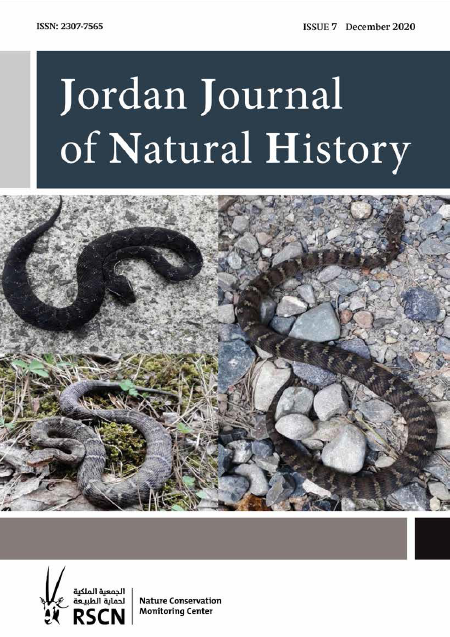Articles
Recent Observations on Amphibians and Reptiles in the Hashemite Kingdom of Jordan
Author Name
Lukáš Pola, Vojtěch Hejduk, Tomáš Winkelhöfer, Aleš Zíka, Mohammad A. Abu Baker and Zuhair S. Amr
The herpetofauna of Jordan has been extensively studied over the past few decades not only by local herpetologists but by foreign ones as well. Additional information on the current status, distribution, and ecology of amphibians and reptiles is indeed crucial for the conservation authorities as it enables them to take an inventory of certain areas together with some protection and conservation actions. Herein, this study reports observations of three amphibians and thirty two reptile species along with some distributional and ecological notes.
Vertebrate Specimens Deposited at Kurdistan Natural History Museum
Author Name
Zohair I. F.Rahemo and Sarbaz I. Mohammed
The Kurdistan Natural History Museum (KNHM) at Salahaddin University is a recognized Iraqi university-based museum. It serves as an important resource for undergraduate and graduate education, with the aim of collecting and studying the biodiversity in Iraq especially of vertebrates (fishes, amphibians, reptiles, birds, and mammals) since 2003. A total of 106 specimens of vertebrates were collected from the Kurdistan region, including Erbil, Duhok, and Sulaimaniyah provinces and northeastern Iraq. The specimens included nineteen species of fishes belonging to four families, four amphibians belonging to four families, forty-one reptiles belonging to nine families, twenty-five bird species belonging to fourteen families, and nineteen species of mammals belonging to eleven families. All specimens were preserved, or taxidermed in a standard method followed by international museums. Some suggestions are listed to improve and increase the number of museum specimens.
Assessment of Macrobenthic Invertebrate Fauna and Physicochemical Characteristics of Etim Ekpo River, South-South, Nigeria
Author Name
Udeme E. Jonah, Emeka D. Anyanwu and Diane A. Avoaja
The benthic macroinvertebrate fauna and the physicochemical characteristics of Etim Ekpo River in South-South, Nigeria
were investigated from November 2018 to August 2019 in three stations. The aim was to relate the water quality and benthic macroinvertebrate fauna to the anthropogenic activities in the river. Standard methods were used in the collection and analyses of the water samples while Van veen grab was used to collect the benthic macroinvertebrates fauna. The mean values of physicochemical parameters were: water temperature (26.3- 26.5ºC), dissolved oxygen (3.18– 4.83 mg/L), electrical conductivity (109.4– 112.4 μS/cm), pH (6.2 – 6.9), total dissolved solids (68.1–73.4 mg/L), total suspended solids (29.5 – 37.5mg/L), biochemical oxygen demand (3.6 – 4.5 mg/L), phosphate (5.7 – 8.7 mg/L) and nitrate (11.3 – 18.2 mg/L). Higher values in most of the parameters were recorded in Stations 1 and 3. Three phyla of macrobenthic invertebrates were recorded; Arthropoda, represented by five species; Polychaeta represented the annelids while mollusca was represented by two gastropod snails. Arthropoda had the highest percentage of abundance (73.7%), followed by Annelids (21.9%) while Mollusca had the least (4.4%). Macromia magnifica was the dominant species with a relative abundance of 27.97% while Pila ovate was the least abundant (1.63%). Most of the benthic macroinvertebrates recorded were pollution tolerant species, while the biodiversity indices indicated a disturbed environment. The benthic macrofauna and the physicochemical characteristics showed that the river has been seriously impacted by some of the anthropogenic activities going on in the watershed.
The Current Conservation Status of some Wild Plant Species in the District of Bannu, Pakistan
Author Name
Musharaf Khan, Farrukh Hussain, Abdurehman, Shahana Musharaf, Imdad Ullah and Muhammad Khalil
The present study documents the conservation status of 135 plant species belonging to 115 genera and thirtyeight families in Bannu. The information about conservation was collected through questioners, personal observation, group discussions and interviews. The Asteraceae constitutes a dominant family with twenty species followed by Poaceae with nineteen species. In the present report, fifty-two species (38.52 %) were found to be rare, vulnerable (45 Species; 33.33%), Infrequent (18 species; 13.33%), endangered (12 Species; 8.89%) and eight species (5.93%) were dominant. It was not possible through the present investigation to conclude that most wild plant species are going to become endangered due to urbanization and agriculture in the area though natural vegetation habitats are changing rapidly.
Melanism in the Ussuri Pitviper (Gloydius ussuriensis) from the Republic of Korea, with Remarks on Color Variations
Author Name
Yucheol Shin, and Amaël Borzée
Gloydius ussuriensis is a species of pitviper inhabiting eastern Asia. Body coloration of this species is highly variable, but the extent of this variation has not been documented in detail. Herein, this work reports a melanistic individual of this species observed on Jeju island, Republic of Korea. This study confirms that this melanistic G. ussuriensis has never been observed outside Jeju. The geological environment of the island and the insular melanism can be considered as potential explanations.
Taxonomical Studies on the Cephalopods (Cephalopoda: Mollusca) Inhabiting both the Egyptian Mediterranean and the Red Sea Waters
Author Name
Rafik Riad
Specimens were obtained from fishing trawlers operating in the Egyptian Mediterranean Sea, the Suez Gulf, and the Red Sea. Specimens were also obtained from Alexandria and Suez fish markets. The species included in the class Cephalopoda are ecologically and commercially important around the world. The class includes four groups: Cuttlefishes, Squids, Octopuses, and Nautilii. The first three groups are present in the Egyptian Mediterranean and the Red Sea waters. They constitute a main component in the fisheries industry. In order to understand the biology and ecology of any species, their identification should be conducted properly to maximize the accuracy of any study. The present work is the first-in-kind, and was prepared to focus on the cephalopod species inhabiting both the Egyptian Mediterranean and the Red Sea waters. Six cephalopod species inhabit both the Egyptian Mediterranean and the Red Sea waters; these include one cuttlefish species: Sepia dollfusi, two squid species: Loligo forbesi and Sepioteuthis lessonian, and three octopus species: Octopus vulgaris, Octopus macropus, and Octopus defilippi. Two of them, namely Sepia dollfusi, and, Sepioteuthis lessoniana dwelling in the Red Sea and migrated to the Mediterranean waters through the Suez Canal. Specimen parts were drawn by means of a zoom stereoscopic microscope provided with a camera lucida drawing tube and the specimen parts were also photographed by a Canon digital camera.
The Garo Tribe’s Ethnobotanical Knowledge about Medicinal Plants
Author Name
Mohammad Shafiqul Islam and Abul Khayer M. Golam Sarwar
Ethnic communities have primarily relied on forest resources to fulfil their demands of food, nutrition, and medicinal requirements since the time of immemorial. The Garos are one of the few remaining matrilineal societies in the world. An investigation was conducted to understand the knowledge the ethnic Garo peoples of Bangladesh have about the medicinal plants (MPs). The present study was done through structured questionnaires in consultations with the tribal herbal practitioners. A total of eighty-eight species belonging to fifty-one families and eighty-two genera were collected and recorded for their use against 104 ailments by the Garo people. Some diseases, e.g., fever, cough, diarrhea, skin diseases, constipation, catarrh, etc., were very common and could be treated with more than one plant. Six, out of ten, of the world top deadliest diseases, viz. heart diseases, bronchitis, diabetes, diarrheal diseases, tuberculosis, and cirrhosis, were treated by the ethnic Garo people with the help of medicinal plants. The major growth habits of these MPs include herbs (43; 49%), trees (26; 30%), shrubs (11; 13%) and climbers (8; 9%). Individually the fruits of the MPs were found to be leading the plant parts most used in the treatments followed by leaves, bark; however, combining more than one part viz. root, stem, leaf, fruit, and seeds or using the whole plant, occupies the lion share (54%) of the plant parts used for therapeutic purposes. The study confirms that the present information on MPs can be used in the field of botanical, pharmacological, and conservation research and for new drug discoveries in the future.
Morphometric and Meristic Variation in Twelve Different Populations of Garra rufa (Heckel, 1843) from Iran
Author Name
Mazaher Zamani-Faradonbe, Yazdan Keivany, Mojtaba Abbasi Jeshvaghani and Mohammad Asadi-Namavar
This study is carried out to examine the meristic characteristics and variations in the body shape of the red stone lapper, Garra rufa (Heckel, 1843) living in many river systems including the Tigris, Jarrahi, Zohreh, and Mond Basins using geometric and classical morphometric methods. The morphological differences of twelve populations of red stone lapper, G. rufa from Iranian inland water basins were studied using meristic, morphometric, and geometric (Landmark-point) methods. For this aim, twelve meristic characters were counted, nineteen classical morphometrics were measured, and sixteen ratios were calculated. As for the geometric part, thirteen homologous landmark-points were digitized using tpsDig2 software. All analyses showed significant differences in seven meristic and nineteen morphometric characters among the populations. Further analyses including PCA, CVA, and CA of geometric data have shown that there are significant differences in the head region and dorsal-fin base among the G. rufa populations. These results suggest that classical and geometric morphometric methods can distinguish red stone lapper populations of the Iranian inland waters from each other; the differences in body shape suggest that habitat parameters including physicochemical parameters may have caused these patterns of variation in the body shape of fishes.
The First Record of Hottentotta jayakari (Pocock, 1895) from Qatar
Author Name
Mohammad Al-Saraireh and Zuhair S. Amr
The present note provides the first record of Hottentotta jayakari (Pocock, 1895) from Qatar.




